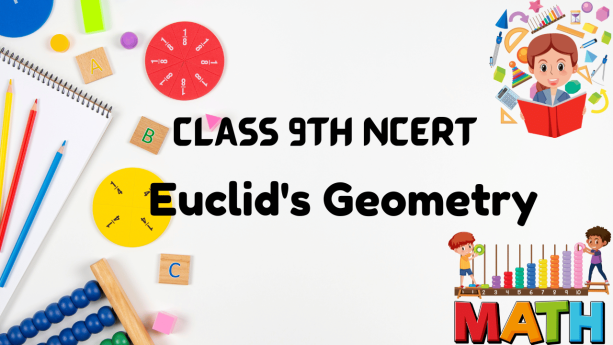We have shared all about short notes of Euclid’s Geometry Class 9th along with the ncert solutions for class 9th Euclid’s Geometry to help the students of class 9th with the solutions and make them understand the chapter thoroughly.
We have shared Euclid’s Geometry Class 9th Maths NCERT to help the students of class 9th to make them understand the lesson better and give them the solutions to ncert exercises so that they can grasp the chapter Euclid’s Geometry Class 9th.
Euclid’s Geometry Class 9th: Introduction
Definitions in Euclidean Geometry
During Euclid’s period, the notations of points, lines, planes (or surface), and so on were
derived from what was seen around them.
Some of the definitions given in him are as follows:
o A point is that which has no part.
o A line is breadthless length.
o A straight line lies evenly with the points on itself.
o A surface is that which has length and breadth only.
o The edges of a surface are lines.
o A plane surface lies evenly with straight lines on itself.
Euclid’s axioms
Axioms are assumptions that are apparent universal truths but are not proven. These
are used throughout mathematics and are not explicitly linked to geometry.
Some of Euclid’s axioms are as follows
o Things that are equal to the same things are equal.
o If equals are added to equals, then the wholes are also equal.
o If equals are subtracted from equals, then the remainders are equal.
o Things that coincide with one another are equal.
o The whole is greater than the part.
o Things that are double the same things are equal.
o Things that are halves of the same things are equal.
Euclid’s postulates
Postulates are also universal truths that need not be proved. Euclid used the term
“postulate” for the assumptions specific to geometry.
Postulate 1: It is possible to draw a straight line from any point to any other point.
Euclid has frequently assumed this postulate without mentioning that there is
a unique line joining two distinct points. The above result can be stated as an
axiom as follows.
Axiom: Given two distinct points, a unique line passes through them.
Postulate 2: A terminated line can be produced indefinitely.
Note: According to present-day terms, the second postulate states that a line segment can
be extended on either side to form a line.
Postulate 3: It is possible to describe a circle with any center and radius.
Postulate 4: All right angles are equal.
Postulate 5:
If a straight line falling on two straight lines forms interior angles that together measure less
than two right angles on the same side of it, then the two straight lines, when produced
indefinitely, meet on that side on which the sum of the angles is less than two right angles.
Euclid’s fifth postulate is also called the parallel postulate.
Two cases arise from this postulate
Case 1: If the sum of the two angles is more significant than the two right angles, then the two lines will
never meet, no matter how long they are extended in that direction.
Case 2: If the sum of the two angles is precisely equal to two right angles, then the two lines
will never meet, no matter how long they continue in both directions.
Playfair’s axiom is the alternative to Euclid’s fifth postulate, which can be stated as:
For every line in a plane, there exists another unique line in the exact plane parallel to the
given line, which passes through a point placed at a certain distance from that line.
Euclid’s Geometry Class 9th: NCERT Solutions for Class 9 Euclid’s Geometry
We have shared NCERT Solutions for Class 9 Euclid’s Geometry to help the students with the solutions of Euclid’s Geometry Class 9th to give them the best solutions and help them in every way.
NCERT Solutions for Class 9 Maths Chapter 5 Introduction to Euclid Geometry Ex 5.1
Ex 5.1 Class 9 Maths Question 1.
Which of the following statements are true and which are false? Give reasons for your answers.
(i) Only one line can pass through a single point.
(ii) An infinite number of lines pass through two distinct points.
(iii) A terminated line can be produced indefinitely on both sides.
(iv) If two circles are equal, their radii are equal.
(v) In figure, if AB – PQ and PQ = XY, then AB = XY.
![]()
Solution:
(i) False
Reason: If we mark a point O on the surface of a paper. Using pencil and scale, we can draw an infinite number of straight lines passing
through O.
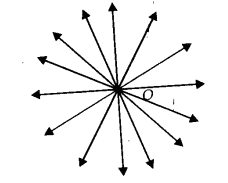

(ii) False
Reason: In the following figure, many straight lines pass through P. Many lines are passing through Q. But there is one and only one line which is passing through P as well as Q.
(iii) True
Reason: Postulate 2 says, “A terminated line can be produced indefinitely.”
(iv) True
Reason: We find them coinciding by superimposing the region of one circle on the other. So, their centers and boundaries coincide.
Thus, their radii will coincide or equal.
(v) True
Reason : According to Euclid’s axiom, things which are equal to the same thing are equal to one another.
Ex 5.1 Class 9 Maths Question 2.
Give a definition for each of the following terms. Are there other terms that need to be defined first? What are they and how might you define them?
(i) Parallel lines
(ii) Perpendicular lines
(iii) Line segment
(iv) Radius of a circle
(v) Square
Solution:
Yes, we need to know about the terms like point, line, ray, angle, plane, circle, and quadrilateral, etc., before defining the required terms.
Definitions of the required terms are given below:
(i) Parallel Lines:
Two lines l and m in a plane are said to be parallel if they have no common point, and we write them as l ॥ m.

ii) Perpendicular Lines:
Two lines p and q lying in the same plane are said to be perpendicular if they form a right angle, and we write them as p ⊥ q.
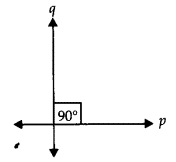
(iii) Line Segment:
A line segment is a part of line and has a definite length. It has two end points. In the figure, a line segment has endpoints A and B. It is written as AB¯¯¯¯¯¯¯¯ or BA¯¯¯¯¯¯¯¯.
(iv) Radius of a circle :
The distance from the center to a point on the circle is called the radius of the circle. In the figure, P is center and Q is a point on the circle, then PQ is the radius.

(v) Square :
A quadrilateral in which all the four angles are right angles and all the four sides are equal is called a square. Given the figure, PQRS is a square.
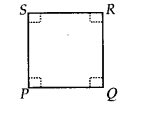
Ex 5.1 Class 9 Maths Question 3.
Consider two ‘postulates’ given below
(i) Given any two distinct points A and B, there exists a third point C which is in between A and B.
(ii) There exist atleast three points that are not on the same line.
Do these postulates contain any undefined terms? Are these postulates consistent? Do they follow from Euclid’s postulates? Explain.
Solution:
Yes, these postulates contain undefined terms such as ‘Point and Line. Also, these postulates are consistent because they deal with two different situations as
(i) says that given two points A and B, there is a point C on the line between them. Whereas
(ii) says that, given points A and B, you can take point C, not lying on the line through A and B.
No, these postulates do not follow Euclid’s postulates. However, they follow from the axiom, “Given two distinct points, there is a unique line that passes through them.”
Ex 5.1 Class 9 Maths Question 4.
If point C lies between two points A and B such that AC = BC, then prove that AC = 12 AB, explain by drawing the figure.
Solution:
We have,
![]()
AC = BC [Given]
∴ AC + AC = BC + AC
[If equals are added to equals, then wholes are equal]
or 2AC = AB [∵ AC + BC = AB]
or AC = 12AB
Ex 5.1 Class 9 Maths Question 5.
In question 4, point C is called a mid-point of line segment AB. Prove that every line segment has one and only one mid-point.
Solution:
Let the given line AB have two midpoints, ‘ C’ and ‘D.’
![]()
AC = 12AB ……(i)
and AD = 12AB ……(ii)
Subtracting (i) from (ii), we have
AD – AC = 12AB−12AB
or AD – AC = 0 or CD = 0
∴ C and D coincide.
Thus, every line segment has one and only one mid-point.
Ex 5.1 Class 9 Maths Question 6.
In figure, if AC = BD, then prove that AB = CD.

Solution:
Given: AC = BD
⇒ AB + BC = BC + CD
Subtracting BC from both sides, we get
AB + BC – BC = BC + CD – BC
[When equals are subtracted from equals, remainders are equal]
⇒ AB = CD
Ex 5.1 Class 9 Maths Question 7.
Why is Axiom 5 considered a universal truth’ in the list of Euclid’s axioms? (Note that the question is not about the fifth postulate.)
Solution:
As the statement is valid in all situations. Hence, it is considered a ‘universal truth.’
NCERT Solutions for Class 9 Maths Chapter 5 Introduction to Euclid Geometry Ex 5.2
Ex 5.2 Class 9 Maths Question 1.
How would you rewrite Euclid’s fifth postulate to be easier to understand?
Solution:
We can write Euclid’s fifth postulate as ‘Two distinct intersecting lines cannot be parallel to the same line.’
Ex 5.2 Class 9 Maths Question 2.
Does Euclid’s fifth postulate imply the existence of parallel lines? Explain.
Solution:
Yes. If a straight line l falls on two lines m and n such that the sum of the interior angles on one side of l is two right angles, then by Euclid’s fifth postulate, lines m and n will not meet on this side of l. Also, we know that the sum of the interior angles on the other side of the line l will be two right angles too. Thus, they will not meet on the other side also.
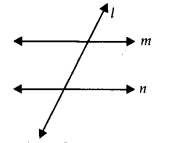
∴ The lines m and n never meet, i.e, They are parallel.

